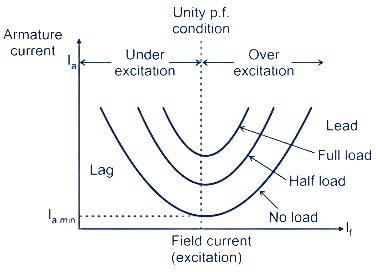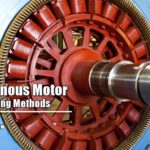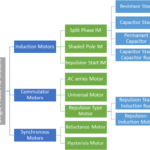This set of Electrical Machines Multiple Choice Questions & Answers (MCQs) focuses on “Synchronous Motors ”. This is a set of Synchronous Motors MCQ with detailed solution.
Synchronous Motor MCQ Question 1
A synchronous motor can operate at
(A) Lagging power factor only
(B) Leading power factor only
(C) Unity power factor only
(D) Lagging, leading and unity power factor
Answer (Detailed Solution Below)
(D) Lagging, leading and unity power factor
Detailed Solution
Synchronous motor:
V curves for synchronous motor gives the relation between armature current and DC field current. The curves are shown below.
A synchronous motor is capable of operating at all types of power factor i.e. either UPF, leading, or lagging power factor.
Lagging power factor: If field excitation is such that Eb < V the motor is said to be under excited and it has a lagging power factor.
Leading power factor: If field excitation is such that Eb > V the motor is said to be over-excited and it draws leading current. So that the power factor improves.
Unity power factor: If field excitation is such that Eb = V the motor is said to be normally excited.
Synchronous Motor MCQ Question 2
An unexcited single-phase synchronous motor is
(A) reluctance motor
(B) repulsion motor
(C) universal motor
(D) AC series motor.
Answer (Detailed Solution Below)
(A) reluctance motor
Detailed Solution
Unexcited single phase synchronous motor runs at constant speed equal to synchronous speed of revolving flux. They do not need a dc excitation for their rotors.
Reluctance motor and Hysteresis motors are unexcited single phase synchronous motors.
Reluctance Motor
It is a single-phase synchronous motor that does not require DC excitation to the rotor. Its operation is based upon the following principle:
Whenever a piece of ferromagnetic material is located in a magnetic field, a force is exerted on the material, tending to align the material so that reluctance of the magnetic path that passes through the material is minimized.
3. The maximum power developed in the synchronous motor will depend on
(A) rotor excitation only
(B) the maximum value of the coupling angle
(C) supply voltage only
(D) rotor excitation supply voltage and maximum value of coupling angle
Answer (Detailed Solution Below)
(D) Lagging, leading and unity power factor
4. In case the field of a synchronous motor is under excited, the power factor will be
(A) leading(B) lagging(C) zero(D) unity
5. Synchronous motor is switched on to supply with its field windings shorted on themselves. It will
(A) not start(B) start and continue to run as an induction motor(C) start as an induction motor and then run as a synchronous motor(D) bum immediately
6. When the excitation of an unloaded salient pole synchronous motor gets disconnected
(A) the motor will bum(B) the motor will stop(C) the motor will ran as a reluctance motor at the same speed(D) the motor will run as a reluctance motor at a lower speed
7. The damping winding in a synchronous motor is generally used
(A) to provide starting torque only(B) to reduce the noise level(C) to reduce eddy currents(D) to prevent hunting and provide the starting torque
8. The back emf set up in the stator of a synchronous motor will depend on
(A) rotor speed only(B) rotor excitation only(C) rotor excitation and rotor speed(D) coupling angle, rotor speed and excitation.
9. Synchronous motor is a useful industrial machine on account of which of the following reasons?
I. It improves the power factor of the complete installation
II. Its speed is constant at all loads, provided mains frequency remains constant
III. It can always be adjusted to operate at unity power factor for optimum efficiency and economy.
(A) I only
(B) II only
(C) III only
(D) I, II and III
10. Which of the following is an unexcited single-phase synchronous motor?
(A) A.C. series motor
(B) Universal motor
(C) Reluctance motor
(D) Repulsion motor




